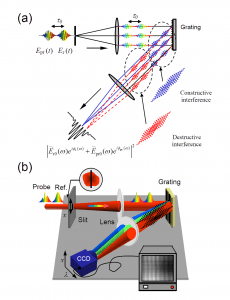Spectrally interfering broadband, coherent white light pulses in a pump probe experiment enables single shot measurements of refractive index transients on a few femtosecond time scale.
Ultrafast laser pulses can strongly perturb any material they’re propagating through. Atoms and molecules can be distorted, stretched, rotated, and have their electrons removed by the laser field. These fundamental microscopic dynamics introduce strong feedback on the laser propagation, so details about these processes are fundamental to understanding and modeling nonlinear optics in intense laser fields. Using high bandwidth pulses, our lab pioneered the use of single-shot supercontinuum spectral interferometry (SSSI) as a way to precisely measure the response of atoms, molecules, and plasmas to ultrafast laser fields.
Our technique uses a chirped broadband, coherent supercontinuum pulse (generated by filamentation in a high pressure gas cell), splits it in two copies and sends it through a test region. The first pulse is a reference, while the second one (the ‘probe’ pulse) is overlapped with a pump beam that changes the local index of refraction and thus the phase fronts on the probe. Even though the reference and probe pulses are separated in time, they can still interfere in an imaging spectrometer, since a diffraction grating will stretch the pulses till they overlap as shown in the figure below. Shifts in the spectral interference fringes measured on a CCD camera in the spectrometer’s focal plane then enable extraction of the pump-induced cross phase modulation on the probe, and thus the pump-induced refractive index transient. Since each frequency of light in the chirped supercontinuum pulse arrives at the target region at a different time, the spectral information also gives a complete time history of the index over the length of the chirped pulse, with temporal resolution on the order of femtoseconds. A recent paper from our lab explores the absolute limits of temporal resolution with SSSI.
Images from [1].
The technique is a big improvement over conventional multi-shot pump-probe experiments, since it captures the full transient dynamics in a single shot. This makes SSSI especially well-suited for single shot measurements of highly nonlinear events with shot-to-shot fluctuations, since a multi-shot pump-probe experiment would average over potentially important shot to shot variations in signal temporal structure.
Using this powerful measurement tool, we have been able to determine the absolute refractive index response arising from the electronic and rovibrational nonlinearity of a variety of materials and gases (such as air constituents, molecular hydrogen and water), including the response driven at the mid-infrared and long-wave infrared wavelengths new to ultrashort laser systems, and even showed how SSSI measurements can be a powerful diagnostic for spatial and temporal beam profiles. We also showed that the linear increase in this bound electron nonlinearity with increasing intensity continues well into the nonperturbative regime, where electrons are significantly ionized by the strong pump pulse. These fundamental measurements have in turn enabled related experiments in filament propagation and quantum revivals of rovibrational states in air. Studies of these quantum revivals further enabled demonstration of quantum molecular lensing in filament wakes, trapping and destruction of filaments, extension of filament propagation, and even coherent control of gas hydrodynamics. A review paper of the application of SSSI to studying filaments and their applications can be found here.
References:
[1] K. Y. Kim, PhD Dissertation (University of Maryland, 2002).


